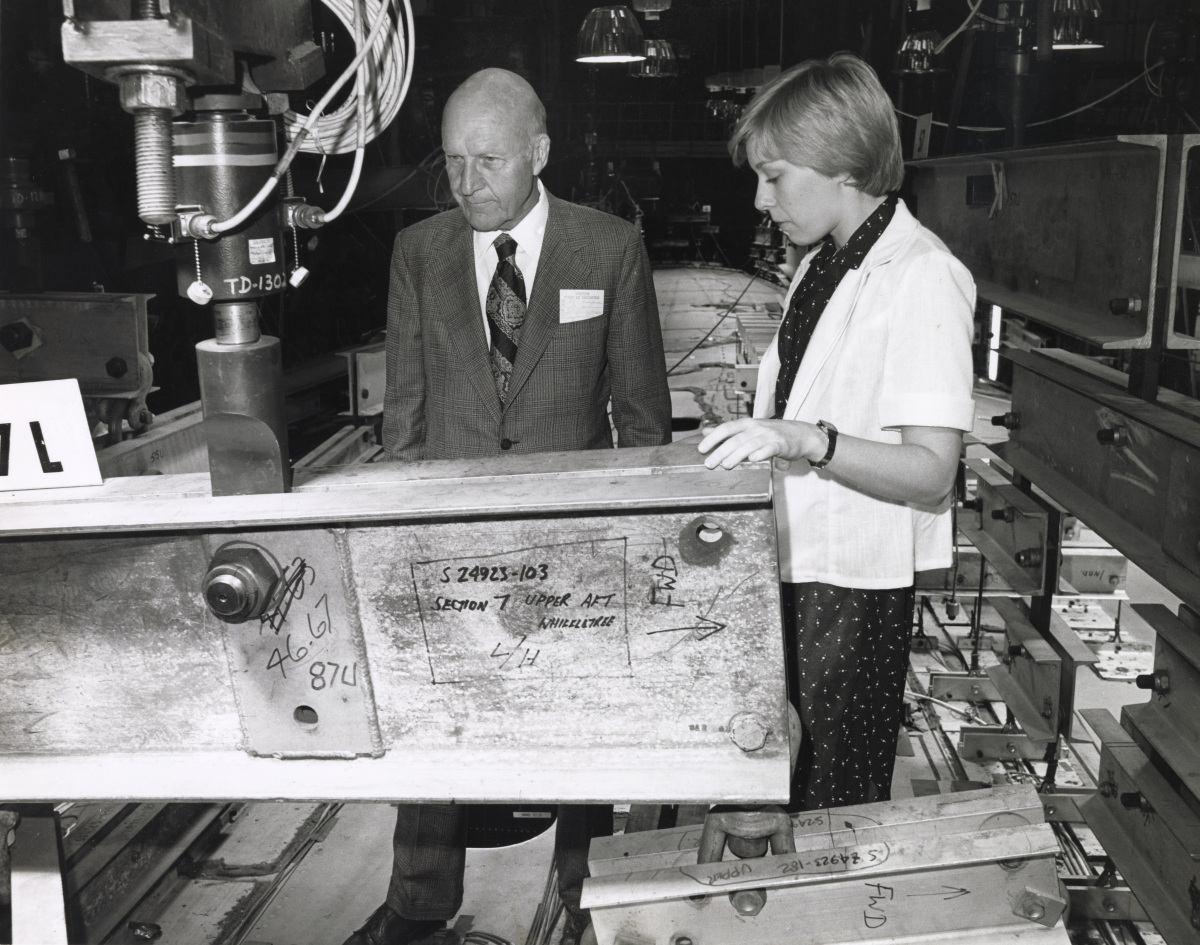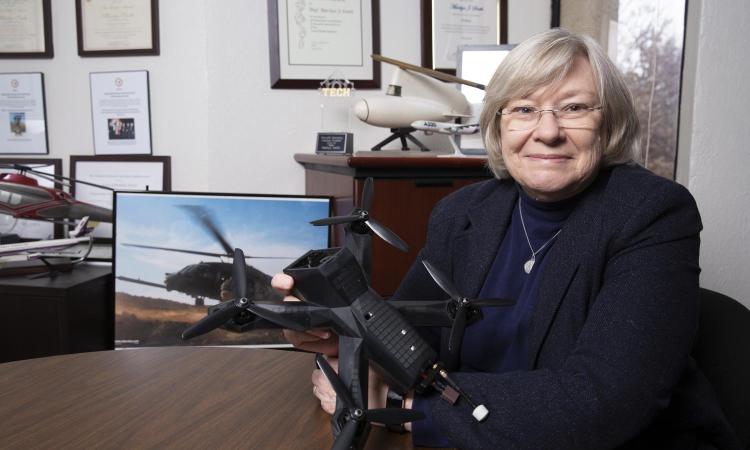The early years and determination of Professor Marilyn Smith.

Marilyn Smith in the early 1980's at Lockheed developing computational flight test analysis software.
(text and background only visible when logged in)
Professor Marilyn Smith was often overlooked and told ‘no’ simply because of her gender, but found support along the way, which propelled her to become one of the leading researchers in vertical lift.
She made history as Lockheed Martin’s first woman flight test engineer and later as the first female faculty member hired by the Daniel Guggenheim School of Aerospace Engineering (AE) at Georgia Tech.
Her journey was far from easy, which motivated her to dedicate her career to opening doors and paving the way for women who followed. Now, a new scholarship established in her honor will continue her legacy, helping future generations pursue excellence, just as she has.
Born to Fly
Smith, AE 1982, M.S. AE 1985, Ph.D. AE 1994, was just two weeks old when she took her first flight. Her mother would joke when the future scholar chose aerospace, though Smith teased that she had other early influences. The flight was from the Châteauroux-Déols Air Force Base hospital to Laon, France, where her father worked as an airman, and her mom worked as a secretary.
As the oldest of four daughters, Smith assumed the role of the “responsible one” and at a young age, learned to cook and help her mother alter clothing to earn money, all while making sure her younger sisters did their chores and stayed out of trouble. “When I was a kid, I was always tinkering with things. I watched Star Trek almost daily, much to my father’s chagrin, but I found an affinity for aerospace,” Smith said.
Despite her busy home life, she excelled in the classroom and skipped one grade. There was talk of skipping two grades, but the school system wouldn’t allow it.
Teachers and school administrators didn’t know what to do with me because I was so outside the mold
MARILYN SMITH
“By the time I got to high school, the junior high school administration had begun making changes to their policies because of my experience.”
At that time – the early 1970s, girls weren’t allowed to take drafting or woodshop classes. Instead, Smith was forced into home economics and sewing classes — skills she already possessed thanks to her mom. It wasn’t the last time people told, or tried to tell, Smith what she was supposed to do.
Not ‘Lady-Like’
As she got older, she grew increasingly tired of people telling her what she could and couldn’t do simply because she was a girl. She couldn’t be better than the boys. She couldn’t take a higher mathematics course and score higher than the boys.
That’s not “lady-like,” adults would tell her. It was a phrase she heard often, and one that fueled her determination to prove them wrong. Her response? “Watch me.”
Encouragement from her high school geometry teacher helped her see that she could one day use her gifts to become an engineer.
“He was a great teacher who let students go at their own pace, so I did two years’ worth of geometry in one year,” she said. “One day, he looked at me and said, ‘You’re an engineer,’ I didn’t know it was possible for me to become an engineer, but he was right - I am an engineer.”

Smith (right) and a Lockheed executive, look over the C-5 wingbox structural fatigue test.
(text and background only visible when logged in)

Smith (middle) and colleagues look over the production floor of the Lockheed office in Marietta, Georgia.
Earning Her (Yellow Jacket) Wings
When she was still a baby, her father left the Air Force and her family moved from Laon, France first to Burnettown, South Carolina then to North Augusta, South Carolina, where Smith grew up until she left for college.
The exceptional student felt the pressure when deciding what school she’d attend for the next chapter of her life. She was weighing her options between Purdue and Georgia Tech, both known for their engineering programs.
“My mom really wanted me to go to Georgia Tech because it was closer to home,” said Smith, who grew up about three hours from Atlanta. The co-op opportunities at Georgia Tech ended up swaying her decision — and changed the trajectory of her life.
Smith covered 92 percent of her undergraduate tuition through scholarships, part-time jobs, and a co-op position at Lockheed Martin.
She did three co-op rotations at NASA Langley Research Center, the first rotation in space structures. During the second rotation she wrote a Fortran program to model and measure the algae in Rhode Island’s Narragansett Bay, while during the third rotation she supported the general aviation stall and spin program in the flight-testing unit. She later transferred to Lockheed (now Lockheed-Martin) in Marietta, Georgia where she became a flight test engineer.
“My favorite part about co-oping at Lockheed was making enough money to both eat and pay for school, as well as remain close to campus so I could go to football games,” she said.
Her first date to one of those football games was with an electrical engineering student named Robert. The Yellow Jackets lost the game against Clemson, but Robert won Smith’s heart and they married after they both graduated.
In the classroom, she hadn’t considered specializing in rotorcraft, until she enrolled in her first class with Professor Robin Gray, a renowned rotorcraft expert. She thoroughly enjoyed his classes, and he eventually became one of her most influential mentors.
“He told me to not let anything stop me from doing what I wanted and to always double-check my calculations,” Smith said, noting she continues to follow both rules to this day.
Turbulence Ahead
Then, as now, getting a degree in aerospace engineering wasn’t easy. Yet, at times, it was far easier for Smith than battling the sexist beliefs and behaviors of some of the people around her.
She still remembers walking on the flight line at Lockheed one day in her flight suit, jump boots, parachute, and helmet.
“The entire place just stopped,” she recalled. Tools clattered to the ground and people stared — stunned to see a woman flight test engineer.
“I knew I had just done something special because I was the first woman flight test engineer hired at Lockheed.”
Smith excelled at Lockheed and enjoyed what she was doing. She had never considered pursuing a graduate degree until an opportunity presented itself. The company had just started a new employee development program, which later became their Technical Fellows Program.
She was one of two engineers in her division selected to pursue their choice of an MBA or a master’s degree in their technical field at Georgia Tech. She enrolled and found herself juggling full-time work and conducting innovative research.
(text and background only visible when logged in)

Smith showcasing a structural model of the NASP vehicle while working at the Georgia Tech Research Institute (GTRI)
“I knew I had just done something special because I was the first woman flight test engineer hired at Lockheed.”
MARILYN SMITH
As a graduate student, she carpooled from Lockheed Martin’s Marietta office to Georgia Tech with classmate and colleague Susan Kilrain, M.S. AE 1985, who later became a NASA astronaut. On those drives and on campus, they quickly became friends.
“Susan and I were friends.” Smith said. “We helped each other out, being two of very few women in aerospace and at Lockheed.”
When she finished her master’s degree in 1985, Smith became the 11th woman to graduate from Tech with a master’s degree in aerospace engineering. Shortly after, she transferred to Lockheed’s Research and Development group where her work moved from conducting flight tests to running computational fluid dynamics, which is still a part of what she does today.
After only a few weeks with Lockheed’s Advanced Flight Sciences group, the branch chief pulled her and four other engineers aside and said, “You five don’t have Ph.D.s, so I’ve arranged for you to pursue your doctorate part-time at Georgia Tech.”
Smith couldn’t believe she was returning to school yet again, but she was up for the challenge and wanted to be the best engineer she could be.
While earning her Ph.D., she moved to Arizona to work at McDonnell-Douglas Helicopter, became a mom, moved back to Georgia, and started working at the Georgia Tech Research Institute (GTRI). Along the way, she had to change her thesis topic three times. This year marks 30 years since she successfully defended her thesis, A Fourth Order Euler/Navier-Stokes Prediction Method for the Aerodynamics and Aeroelasticity of Hovering Rotor Blades.
Smith spent seven years working on various aircraft projects at GTRI, under the leadership of fellow AE alumnus and former NASA Administrator Richard Truly, AE 1959. GTRI had launched a new program where its engineers could also teach at Georgia Tech, so after some encouragement from AE Professor Al Pierce, Smith found herself teaching the next generation of engineers at her alma mater.
Leading and Mentoring the Next Generation
In the fall of 1997, Smith joined the AE faculty full-time as an assistant professor, becoming the first female faculty member hired in the Daniel Guggenheim School of Aerospace Engineering.
Navigating through Tech as a new faculty member wasn’t easy, but she found guidance through her office neighbor, Professor Dewey Hodges which began a 24-year mentorship and friendship.
Over the course of her 27-year journey at Tech, Smith has conducted more than $200 million in research with the U.S. Army, U.S. Navy, and NASA, and published more than 300 technical papers. She’s taught aeroelasticity courses at both the undergraduate and graduate-level, advised more than 18 Ph.D. students who went on to earn their doctorates, and has five more in the pipeline.
She’s served as a mentor to countless Georgia Tech students and has devoted time and attention to guiding young faculty members, too.
“Working alongside Dr. Smith, I was not only exposed to the cutting-edge of vertical flight aerodynamics, but was also nurtured with a kind of guidance and support that is rare and invaluable,” said Carlota Bonnet, AE 2019, MSAE 2022, Ph.D. AE 2024. “Her mentorship extended beyond the technical intricacies of our field; she was there for me through the highs and lows of graduate school, offering wisdom and encouragement that helped me navigate the rigors of academic and personal growth.”
“Professor Smith was my favorite professor as an undergraduate student and was someone I considered both a role model and an inspiration,” said Kelly Griendling, AE lecturer and Triple Yellow Jacket. "I still consider her as such today. I feel extraordinarily lucky that I now get to count her as a colleague, a mentor, and a friend.”

Prof. Marilyn Smith and Carlota Bonnet are all smiles at Bonnet's doctoral graduation ceremony, May 2024.
Prof. Tim Lieuwen (right) and Kelly Griendling (left) award Prof. Marilyn Smith with a custom glass helicopter for her service in teaching and research at Georgia Tech, March 2024.
Many of the talented researchers and students who work with Prof. Marilyn Smith (from left) - Walther Chong, Pranav Sridhar, Jeremy Seeyave, Sheldon Salins, Prof. Smith, Aaron Crawford, Carlota Bonnet, Brenden Oates, Zahra Mehtar, and McKenna Taylor.
Related Stories

$40 Million NASA Award to Increase Rotorcraft Vertical Lift Technology Campus-Wide
Led by Professor Marilyn Smith, a new award from NASA will give Georgia Tech researchers easier and faster access to research and engineering funds to support advances in rotorcraft vertical flight technology.

Cat-alysts of Community: Georgia Tech Campus Cats
Professor Marilyn Smith serves as the faculty advisor for the Georgia Tech Campus Cats which supplies food and water stations for the cats, tracking cat sightings, building weather shelters, and securing veterinary care as needed.